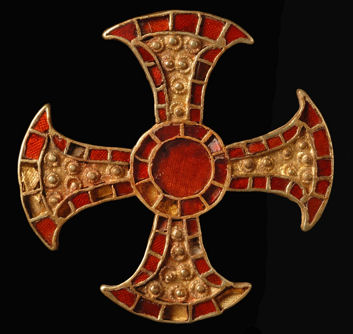
This report is a summary of a talk given at the meeting of the Local History Group by Alison Dickens on 9 May 2019, with the title All That Glisters: Anglo-Saxons, Beds and Gold. Alison Dickens was a senior manager in the Cambridge Archaeological Unit at the time of the meeting. Report by Andrew Roberts.
Alison said that the Trumpington Meadows excavation was completed on site in 2013 and work had now been completed on the post-excavation research and report. A book, Riversides, has been published with details of the extensive evidence from the site.
Alison focused on one aspect of the site, the very special Anglo-Saxon bed burial, with its remarkable ‘bling’ and evidence of the early Christianisation of the country after the Romans had left. From the 5th century, Saxons, Angles and Jutes moved into southern and eastern England. Christianity had been the official religion of the Roman empire in the 4th century but declined after that, with pockets of Christianity including in Ireland and Scotland. In 596, Pope Gregory was responsible for sending St Augustine to Kent and he and his followers concentrated on converting kings and nobles. By the end of the 7th century, England was nominally Christian.
Alison discussed the 7th century phenomenon of bed burials, with two main groups around Cambridgeshire and in the West Country. East Anglian sites include Edix Hill (Barrington), Shudy Camps, Coddenham (Suffolk) and Cherry Hinton. Only 17 such burials are known in England.
The Trumpington Meadows example was excavated in 2010, one of a set of four graves in a settlement area at the northern end of the overall site. The graves are not contemporary with each other but all date from the 7th century and are contemporary with the buildings. The southernmost grave had the burial of a teenage female on a bed, 14-18 years old, with her head at the west end of the grave. There were grave goods closely associated with the body, including an iron knife, purse and chatelaine. A large iron plate held an angled bed head. Alison commented that it was remarkable that organic items had been preserved by mineralisation. The wood may have been decorated. There was also the amazing solid gold pectoral cross inlaid with garnets. Alison said that this is small but with high quality workmanship. There was also a pair of gold pins. Garnets are known from India and Bohemia and are very difficult to work.
Five gold and garnet crosses are now known, from Trumpington, Ixworth (Stanton, Norfolk), Wilton (Lakenheath), St Cuthbert’s grave and Holderness (Yorkshire). Cuthbert’s cross was recovered from his coffin and is on display in Durham Cathedral, dating to c. 687, a symbol of Northumbria. This is the only one related to a man and may have been a gift to Cuthbert from a female. The Holderness example was kept in a drawer for 40 years and is probably from a 7th century cemetery. The Wilton cross was found with a coin, dated to 610-641. The Ixworth cross was found by a quarry worker from a bed burial.
Overall, Alison said we now know of 5 crosses and 17 bed burials, with 2 of the crosses from the bed burials. There was an association in the Anglo-Saxon period between death, beds and sleeping, with the Anglo-Saxon word ‘leger’ meaning bed or grave. Late 7th century bed burials were probably a burial rite for a small number of individuals. They may have been associated with the Christian movement across the country. The Trumpington example may have been a second or third generation Christian.
Alison said that the individual was probably Christian, from a noble and possibly royal family. The settlement may have included the home of an important person or a religious establishment. The grave is the last in the sequence and may mark the end of the settlement. There was then a gap of 200 years to the 9th and 10th centuries before the development of Trumpington village, close to the site of the church.
Questions
Q: would the bed have been ceremonial or to sleep in?
A: difficult to answer, it may have been made specifically for the burial.
Q: would the cross have been made here or overseas?
A: garnets may have been imported while the gold is likely to have been from Britain; the cross is likely to have been made in Britain and there is evidence of craft traditions at sites such as Sutton Hoo.
Q: where are the finds?
A: the majority of the excavated finds are in archaeological storage but the finds from the grave are in the Museum of Archaeology and Anthropology and will go on display.
Q: is there any remaining evidence on the ground?
A: no, the site has been developed.
Q: how deep were the graves?
A: 40 cm or so to the top of the grave, deep enough to have been protected from disturbance.
Q: would the body have been covered or shrouded?
A: it would probably have been covered and fully clothed.
Q: any evidence from DNA?
A: there has been no DNA analysis of the Saxon skeletons.
Q: how have the burials been dated?
A: radio-carbon dating of the bones.
Q: what happens to the human remains?
A: Alison said that her personal view was that physical remains have so much to tell us about the individuals and their lives and about our history, including evidence of diseases, and further studies may be possible in the future.
Q: were the four individuals related?
A: they may be but the gaps in time between the burials makes that less likely
Reference
Evans, Christopher, Lucy, Sam and Patten, Rickie (2018). Riversides: Neolithic Barrows, a Beaker Grave, Iron Age and Anglo-Saxon Burials and Settlement at Trumpington, Cambridge (New Archaeologies of the Cambridge Region). Cambridge: Mcdonald Institute.